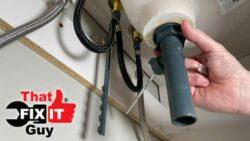In this article, you will discover the most effective method for adjusting a dual flush toilet mechanism. It is essential to ensure that your toilet operates efficiently and conserves water effectively, and understanding how to adjust the dual flush mechanism is crucial in achieving these goals. By following the step-by-step instructions provided, you will be able to optimize your toilet’s performance and make necessary adjustments with ease. Take control of your toilet’s functionality and save both water and money with this comprehensive guide.
Understanding Dual Flush Toilets
What is a dual flush toilet?
A dual flush toilet is a type of toilet that offers two different flushing options, allowing for varying amounts of water to be used. It consists of two buttons or levers, typically located on the top of the toilet tank, which control the flush. One button is for a full flush, intended for solid waste removal, and the other is for a half flush, suitable for liquid waste. Dual flush toilets are designed to promote water conservation and efficiency.
How does a dual flush toilet work?
Dual flush toilets work by utilizing two different amounts of water for flushing. The full flush option typically uses around 1.6 gallons (6 liters) of water and is suitable for solid waste removal. The half flush option uses significantly less water, usually around 0.8 gallons (3 liters), and is suitable for liquid waste. The flushing mechanism inside the toilet tank allows users to select the appropriate flush by pressing the corresponding button or lever.
Why adjust the dual flush toilet mechanism?
It is necessary to adjust the dual flush toilet mechanism to ensure optimal performance and functionality. Over time, the mechanism may experience wear and tear, causing issues such as weak flushing, partial flushing, constant water running, or leaks. Adjusting the mechanism can help address these problems and restore the toilet’s efficiency. Regular maintenance and adjustments also help prolong the lifespan of the toilet and prevent costly repairs.
Identifying Common Issues
Determining if the mechanism needs adjustment
To determine if the dual flush toilet mechanism needs adjustment, there are several signs to look out for. These include weak flushing, where waste is not adequately cleared, partial flushing, where only some of the waste is removed, constant water running, or leaks around the toilet tank. If any of these issues are present, it is likely that the mechanism requires adjustment.
Common problems with dual flush toilets
Some common problems that occur with dual flush toilets include weak flushes, where waste is not effectively cleared, and partial flushes, where only a portion of the waste is removed. Constant water running is another issue, which can be both annoying and wasteful. Additionally, leaks may occur around the toilet tank, leading to water damage and increased water usage. These problems can be addressed by adjusting the dual flush mechanism.
Benefits of adjusting the mechanism
Adjusting the dual flush mechanism offers several benefits. Firstly, it ensures the toilet operates at its optimum level, providing efficient flushing and waste removal. Secondly, adjusting the mechanism can help conserve water, as a properly adjusted dual flush toilet only uses the necessary amount of water for each flush. This helps reduce water bills and contributes to environmental sustainability. Finally, regular adjustments and maintenance extend the lifespan of the toilet and prevent more significant issues from arising.
Preparation
Gather necessary tools
Before adjusting the dual flush toilet mechanism, gather the necessary tools. These typically include an adjustable wrench, channel locks, a flathead screwdriver, and a rag or towel for cleanup. Having these tools readily available will make the adjustment process easier and more efficient.
Ensure safety precautions
Prior to adjusting the dual flush mechanism, it is essential to take safety precautions. Start by turning off the water supply to the toilet. Locate the shut-off valve, usually located near the base of the toilet or on the wall. Turn the valve clockwise to shut off the water flow. This prevents any accidental water leakage or flooding during the adjustment process.
Turn off the water supply
As mentioned above, turning off the water supply is a crucial step to ensure safety and prevent water leakage. Once the shut-off valve is found, turn it clockwise until it is completely closed. This will stop the flow of water into the toilet tank and allow for a hassle-free adjustment process.
Adjusting the Dual Flush Mechanism
Removing the tank lid
To access the dual flush mechanism, start by removing the tank lid. The lid is typically held in place by a few bolts or screws, which can be loosened using a flathead screwdriver or an adjustable wrench. Carefully lift the lid off the tank and set it aside on a clean, stable surface.
Locating the adjustment buttons or rods
Once the tank lid is removed, you will be able to locate the adjustment buttons or rods. These are usually situated at the top of the flush valve, near the center of the tank. Depending on the toilet model, the buttons may be visible and labeled, while the rods may be hidden behind a cover or cap. Take note of their positions before attempting any adjustments.
Understanding different adjustment options
Dual flush toilets offer various adjustment options, depending on the specific model. The most common adjustments involve altering the water level and adjusting the flush buttons or rods. These adjustments can be made using the provided buttons, rods, screws, or by turning specific valves within the toilet tank. Knowing which options are available with your toilet model will help in making accurate adjustments.
Adjusting the water level
To adjust the water level in the tank, locate the water level adjustment screw or valve. It is typically located on top of the fill valve and can be adjusted using a screwdriver or by turning the valve. Increase or decrease the water level as needed, ensuring it is within the recommended range marked inside the tank. Proper water level adjustment is crucial for obtaining efficient flushes.
Adjusting the flush buttons or rods
To adjust the flush buttons or rods, refer to the toilet’s specific instructions or user manual. Some toilets have visible buttons that can be rotated or moved to change the flush volume, while others may have rods that can be adjusted by turning screws. Follow the manufacturer’s guidelines in making the necessary adjustments, ensuring the buttons or rods are properly aligned and functioning.
Testing the adjustments
After making the necessary adjustments to the water level and flush buttons or rods, it is important to test the toilet’s functionality. Turn on the water supply and allow the tank to fill. Try flushing the toilet and observe if the adjustments have improved the flushing performance. Ensure there are no leaks or issues with the flush mechanisms. Make further adjustments if necessary until the toilet is working efficiently.
Dealing with Specific Issues
Fixing a weak flush
If the dual flush toilet is experiencing a weak flush, there are several steps you can take to fix the issue. First, ensure the adjustment buttons or rods are set correctly for a full flush. If the flush volume is still inadequate, check the water level in the tank and adjust it to the recommended level. Additionally, inspect the flush valve for any clogs or obstructions and clean or replace it if necessary. These steps should help restore a strong flush.
Fixing a partial flush
If the toilet only performs a partial flush, adjustments are needed to ensure proper waste removal. Start by checking the adjustment buttons or rods, ensuring they are set correctly for a half flush. If the issue persists, examine the water level in the tank and lower it slightly if it is too high. Partial flushes may also result from a clogged flush valve or a worn-out flapper. Cleaning or replacing these components should resolve the problem.
Addressing constant water running
Constant water running in a dual flush toilet can be caused by several factors. Begin by checking the flapper or flush valve for any damage or misalignment. A damaged flapper should be replaced, while a misaligned flush valve can be adjusted for proper seating. If the issue continues, inspect the fill valve for any leaks or defects and replace it if necessary. Regular maintenance and adjustments can help prevent constant water running.
Handling leaks
Leaking in a dual flush toilet can occur around the tank or the base. If there is a leak around the tank, ensure all bolts and screws securing the tank to the bowl are tight and properly sealed. Replacing the tank-to-bowl gasket may be necessary if it is worn or damaged. Leaks around the base of the toilet are often caused by a faulty wax ring. Replacing the wax ring and ensuring a proper seal should resolve the issue.
Cleaning and Maintenance
Cleaning the toilet components
Regular cleaning of the toilet components is vital for maintaining optimal performance. Start by turning off the water supply and flushing the toilet to empty the tank. Clean the tank, bowl, and other components using a non-abrasive cleaner and a soft brush or cloth. Pay special attention to areas prone to grime or mineral deposits, such as the flush valve and holes. Regular cleaning prevents clogs and helps maintain the toilet’s efficiency.
Inspecting and replacing worn-out parts
Periodically inspect the toilet components for any signs of wear or damage. This includes checking the flush buttons/rods, flapper, flush valve, fill valve, and any seals or gaskets. If any parts appear worn, cracked, or malfunctioning, it is important to replace them promptly. Using genuine manufacturer-recommended parts ensures compatibility and optimal performance.
Scheduling regular maintenance
To ensure the longevity and efficiency of the dual flush toilet, it is advisable to schedule regular maintenance checks. This can be done annually or as recommended by the toilet manufacturer. During these checks, inspect and clean the toilet components, adjust the mechanism if needed, and address any issues that may arise. Regular maintenance prevents unnecessary repairs and extends the lifespan of the toilet.
Advanced Adjustments
Replacing the flush buttons or rods
If the flush buttons or rods are damaged beyond repair or if you wish to upgrade the toilet’s aesthetics, replacing them is an advanced adjustment option. Remove the old buttons or rods according to the manufacturer’s instructions, and install the new ones in their place. Ensure proper alignment and functionality, and test the flushes to verify the adjustments. This upgrade can provide a fresh look to the toilet while maintaining its efficiency.
Upgrading the dual flush mechanism
For those who desire enhanced flushing performance or advanced features, upgrading the dual flush mechanism may be an option. Consult the toilet manufacturer or a professional plumber to discuss available upgrades and compatibility with your existing toilet. Upgrading the mechanism can provide improved water efficiency, quieter operation, or customizable flushing options, depending on the chosen upgrade.
Consulting a professional plumber
In some instances, adjusting a dual flush toilet mechanism may require expert knowledge and experience. If you encounter complex issues or do not feel confident in handling the adjustments yourself, it is advisable to consult a professional plumber. They can accurately diagnose and resolve any problems, ensuring the toilet functions optimally. Professional assistance can save time, effort, and potential damage caused by incorrect adjustments.
Troubleshooting Tips
Identifying other potential issues
While adjusting the dual flush toilet mechanism, it is essential to be aware of other potential issues that may affect the toilet’s performance. These can include faulty fill valves, clogged drain lines, damaged or worn-out seals, or improper tank-to-bowl connections. Being vigilant and addressing these issues promptly can prevent further damage to the toilet and ensure its efficient operation.
Troubleshooting common problems
Some common problems faced with dual flush toilets can often be resolved through troubleshooting. For weak flushes, check for clogs or obstructions in the pipes or flush valve and clean or remove them. Partial flushes can be improved by adjusting the flush buttons or rods for the necessary amount of water. Constant water running may be caused by a faulty flapper or an issue with the fill valve. Troubleshooting these problems can help identify the underlying causes and find appropriate solutions.
When to seek professional help
While many adjustments and troubleshooting can be done independently, there are instances where professional help is necessary. If the issue persists despite multiple adjustments, if there are significant leaks or water damage, or if the toilet is making unusual noises or not functioning at all, it is advisable to seek the assistance of a professional plumber. They have the expertise to diagnose and resolve complex issues, ensuring the toilet is operational and efficient.
Additional Considerations
Water conservation and efficiency
Dual flush toilets are specifically designed to promote water conservation and efficiency. By offering two flush options, users can choose the appropriate amount of water for each flush, minimizing unnecessary water usage. Adjusting and maintaining the dual flush mechanism ensures the toilet operates efficiently and contributes to water conservation efforts. Conserving water not only reduces utility bills but also supports environmental sustainability.
Dual flush toilet maintenance tips
To maintain a dual flush toilet’s efficiency, there are several tips to keep in mind. Regularly clean the toilet components, following the manufacturer’s instructions. Avoid using harsh chemicals or abrasive cleaners that may damage the toilet’s surfaces or components. Refrain from using the toilet as a wastebasket, as flushing non-flushable items can lead to blockages. Lastly, teach household members how to use the appropriate flush option to maximize water conservation.
Comparing dual flush mechanisms
While the general concept of dual flush mechanisms remains consistent, there may be variations in their design and functionality across different brands and models. When considering adjustments or upgrades, it is essential to compare the specific features, flush volume options, durability, and compatibility of different dual flush mechanisms. Researching and consulting experts can help determine the best mechanism for your needs and ensure optimal performance.
Summary of the adjustment process
Adjusting a dual flush toilet mechanism is a crucial maintenance task for optimal performance. By understanding how dual flush toilets work and identifying common issues, one can determine when adjustments are needed. Preparation, including gathering necessary tools and ensuring safety precautions, is essential before starting the adjustment process. Removing the tank lid and locating the adjustment buttons or rods allow for targeted adjustments to optimize the flush mechanism. Dealing with specific issues such as weak flushes, partial flushes, constant water running, and leaks require careful adjustments and component inspections. Regular cleaning, maintenance, and advanced adjustments like replacing buttons or rods or upgrading the mechanism contribute to the toilet’s efficiency and longevity. Troubleshooting tips help identify and resolve potential issues, while additional considerations highlight the importance of water conservation and efficient dual flush mechanisms.
Importance of regular maintenance
Regular maintenance of a dual flush toilet is essential for its optimal performance, longevity, and water conservation. Adjusting the flush mechanism, cleaning the components, inspecting and replacing worn-out parts, and scheduling regular maintenance checks contribute to a well-functioning toilet. Through regular maintenance, potential issues can be identified and resolved promptly, preventing costly repairs and ensuring the toilet operates efficiently. Regular maintenance also helps prolong the lifespan of the toilet, reducing the need for replacements and contributing to environmental sustainability.
Enjoying the benefits of an efficient dual flush toilet
By adjusting the dual flush toilet mechanism and performing regular maintenance, you can enjoy the numerous benefits of an efficient dual flush toilet. Efficient flushing through dual flush mechanisms promotes water conservation and reduces utility bills. Properly adjusted flush buttons or rods ensure waste removal is thorough, eliminating the need for multiple flushes. With regular cleaning and maintenance, the toilet stays sanitary, and potential issues are addressed early on before they become more significant problems. By taking care of your dual flush toilet, you create a more sustainable and efficient bathroom experience.





